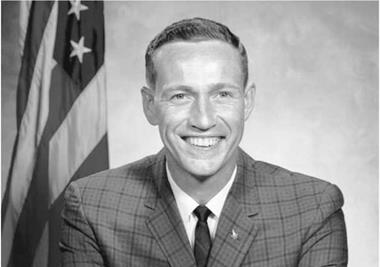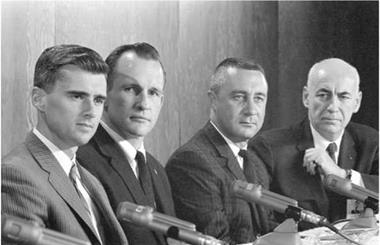APOLLO COMMANDER
By the end of 1965, NASA’s focus was increasingly turning its attention from the highly successful Gemini series of missions to the forthcoming Apollo program. With the first manned orbital flight scheduled before the end of the following year Deke
Slayton, the agency’s Director of Flight Crew Operations, decided it was time to provisionally select the first Apollo crews.
Slayton’s initial choice to command the maiden flight, an Earth-orbiting test of the Apollo spacecraft would, under normal circumstances, have been Alan Shepard. But with Shepard’s flying future still in doubt owing to his affliction with Meniere’s Disease, Slayton opted for another of his experienced Mercury group. “Gus Grissom was going to be coming off the backup assignment to GT-6A,” he explained in his memoirs, “and so was a pretty natural choice for commander of the first mission.”9 Both Grissom and Young served as backups to the prime crew of Wally Schirra and Tom Stafford for this flight, which launched successfully on 15 December 1965 to perform the first orbital rendezvous mission of the program.
Also working in Grissom’s favor as command pilot for the first Apollo mission was the fact that he served as director of the Gemini program in the astronaut office before being named command pilot for the first two-man space flight. In February 1966 he was named to head the Apollo program in that office, so it seemed history would repeat itself.10
America’s first spacewalker Ed White was another name Slayton had penciled in for the first Apollo crew. With the lunar module still under development, there was no requirement for a lunar module pilot on this Earth-orbiting test flight, so Slayton decided he could assign a ‘rookie’ crewman to occupy the third seat, and his choice came down to two suitable candidates – Donn Eisele and Roger Chaffee. Both were Group 3 astronauts who had earlier been paired on tests of the lunar spacesuit’s life-support systems. But as the choice came down to a question of crew compatibility, Slayton decided that Eisele might be a better fit. He now had his first Apollo crew, although the three names still had to be submitted to NASA headquarters for the agency’s approval and official confirmation. His judgment in selecting crews had proven rock-solid in the past, so he envisaged little or no problems in having these three men approved.
|
NASA astronaut Donn F. Eisele. (Photo: NASA) |
Unexpectedly, fate then brought about a last-minute crew change. In September 1964 Eisele had been participating in zero-gravity training aboard a NASA KC-135 aircraft when he accidentally dislocated his left shoulder. The injury had healed, but much to his chagrin Eisele dislocated the shoulder a second time in January 1966 while taking part in some strenuous physical exercises. This fresh injury prompted Slayton to replace Eisele with Chaffee on the crew list that he submitted to NASA headquarters.
Disappointed, but determined to make good and be reassigned, Eisele eventually overcame his shoulder injury and was provisionally assigned to the second planned Apollo mission along with Wally Schirra and Walt Cunningham. In view of some conjecture regarding early Apollo crewing, these crew changes were all verified by Eisele’s first wife, Harriett, by Walt Cunningham, and – prior to his death in 2007 – by Wally Schirra.
For Gus Grissom, Apollo 204 (as it was then designated because it would be the fourth launch of the Apollo IB rocket; ‘Apollo 1’ would be applied later) provided him with the chance to command a second test flight after the unqualified success of Gemini 3. It would also offer further vindication of his character and courage after all the rumors he had endured that he had panicked and blown the hatch on Liberty Bell 7 five years earlier. Had that been the case, it is highly unlikely he would have been awarded the first flight in the Gemini series, let alone the maiden test flight of the Apollo spacecraft whose duration was open-ended up to around two weeks.
In November 1966, Grissom penned a widely syndicated column concerning the upcoming mission in which he revealed his hopes for the mission and for America’s next steps in space. Reproduced here in part, it was published under the title Three Times a Command Pilot.
|
Robert Gilruth (far right) introduces the crew of the first Apollo mission, Roger Chaffee, Ed White and Gus Grissom. (Photo: NASA) |
In Liberty Bell 7, I was a man in a can just along for the ride. Molly Brown, bless her heart, was a machine I could maneuver. And now in Apollo 204, Ed White, Roger Chaffee and I will be in a spacecraft designed to go to the Moon and back.
Soon I’ll be the first United States astronaut to make three flights – one in each of our first three space programs. My upcoming flight is in an Apollo spacecraft which makes my old Mercury Liberty Bell 7 look something like an early flivver [cheap automobile]. But in those days we weren’t all that concerned about maneuverability. We were out to discover whether man could survive G-forces of liftoff and the environment of space. And we learned that man could survive. During the past two years the Gemini program has taught us that we can fly our spacecraft, rendezvous and dock, and even perform meaningful tasks outside the spacecraft.
My fellow crewmembers and I are finding that our Apollo spacecraft is infinitely more complex than Gemini or Mercury. And so is the flight plan, even for our own Earth orbiting mission.
Our job will be to operate and observe and evaluate all of the spacecraft systems. When necessary, we must come up with suggestions for solutions to any problem we encounter. And this we can only do in actual space flight. We may spend anywhere from three to fourteen days in orbit, possibly longer, learning as much as we can about the spacecraft’s performance. Even as we fly the mission, people on the ground will be working to make the Apollo lunar spacecraft an even more sophisticated vehicle than ours.11












